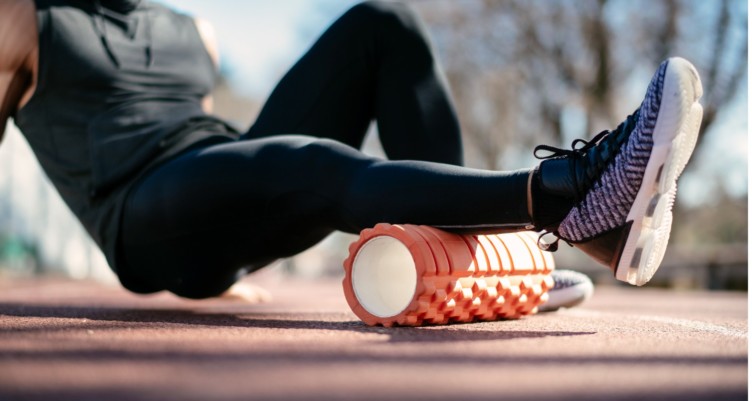Workout Recovery: Tips, Tricks & Why it Matters

- Working out creates small tears in muscle fibers that need time and the proper nutrients to mend and grow.
- Skipping recovery days can lead to issues like muscle pain, exhaustion, mood changes and reduced performance.
- Some of the main areas you should focus on for recovery include hydration and diet, but our list of tips and tricks covers other topics that can help prepare you for your next workout.
Like butter and coffee, workout and recovery go hand in hand.
However, while exercising is beneficial for overall health, pounding the pavement too much can offset those benefits.
Think of your workout recovery as your day(s) off from work. It can be exhausting to work seven days a week without a break for some self-care and relaxation. Spoiler Alert: Your body feels the same way after hours of training, especially if it’s not receiving the proper treatment to heal.
But, what exactly should you do to get back to as close to 100% as possible for your next weightlifting session or HIIT routine? Let us guide you with workout recovery tips to help your body feel rejuvenated and ready to accomplish its next physical challenge.
Benefits of proper workout recovery

FYI: The amount of effort you dedicate to dominating your workout should be equally contributed to your recovery. Why, exactly? When you exercise, you form microscopic tears in your muscle fibers that are repaired by cells called fibroblasts.[1] Giving yourself time to recover allows these cells to do their job of healing and growing the muscle, which, in turn, makes it stronger. Taking time to recover can also help prevent injury from overusing muscles that haven’t had the chance to fully mend.
Exercise also influences hormones, including cortisol—the famed “stress hormone” produced in our adrenal glands. Luckily, intense exercise increases cortisol levels only temporarily—they return to normal afterward. Chances are, if you don’t take adequate recovery time, these stress levels run the risk of staying chronically elevated, which could lead to adrenal insufficiency and the inability to maintain balanced hormone levels.[2] (Yikes!)
Unfortunately, there are even more downsides to skipping that recovery time. Without your trusty post workout recovery, you may start to notice a few unwelcome side effects, like:
- Sore muscles or joint pain
- Exhaustion and fatigue
- Mood changes
- Trouble sleeping
- Reduced performance
So, if you want your next workout to be as good as your last, it pays to invest the time in proper recovery protocols.
Tips and Tricks

The world of workout recovery encompasses many different avenues. From what foods to eat to which drinks to consume to each stretch that you do, there are plenty of ways to help your body repair the damage inflicted by physical activity.
Not sure where to start? We’ve outlined some useful recovery-related tips and tricks that can get you on the right track.
Workout Recovery Drinks
What is the best workout recovery drink? There are many to choose from, and they all serve a different purpose.
First and foremost, recovering with water is crucial. When we exercise, our bodies sweat to regulate body temperature. This sweat comes from the water in our body that contributes to 50-70% of our total mass and is necessary to sustain life[3]. How much valuable H20 is lost via sweat depends on different factors, including the environment, the type of exercise and your own personal sweat rate.
Pro tip: To ensure optimal rehydration, hop on that scale before and after exercise. For every 2.2 pounds lost (1 kg), you’ll need to drink 1 liter of fluid to adequately replace what you lost.[4]
Sweat isn’t just water, though. It also contains electrolytes, which consist of sodium, potassium, chloride and other essential minerals that maintain our fluid balance. However, long-duration or intense exercise typically requires extra electrolyte replacement due to heavy sweating.
Popular ways to reap the electrolytes your body needs in a workout recovery state include sports drinks and coconut water. These options contain nifty electrolytes that can help replenish these minerals and may help you avoid common side effects—adios, muscle cramps, dizziness and nausea![5]
Related: Is Mineral Water Good For You? The Benefits of Drinking Your Minerals
Workout recovery supplements
If you haven’t heard by now, there’s power in the right protein powder!
In fact, a collagen protein supplement can be key to your workout recovery, especially if you find it difficult to meet your macros through your diet. Protein is the building block to life, and you need it in your diet to repair cells and make new ones—including muscle cells.
Education time: A 2018 study gave active females two doses of whey protein hydrolysate (70 ml) for four days. The participants reported improved muscle soreness, function and flexibility.[6] What about collagen protein? A 2008 study followed athletes who supplemented with collagen hydrolysate (aka collagen peptides) over the course of 24 weeks. Compared to the placebo group, the athletes experienced less exercise-induced pain.[7] That’s significant because less pain means better performance during your workouts—so you can bring more of your A-game into the gym.
Put simply, workout recovery-backed protein powders—in the forms of both whey and collagen—hold their ground.
When it comes to supplementing with protein, though, it tends to be a bit of a numbers game. According to the International Society of Sports Nutrition (ISSN), an overall daily protein intake of 1.4 to 2.0 grams of protein per kilogram of body weight is sufficient if you want to build and maintain muscle mass.[8]
We recommend easy-to-sip protein shakes to ensure this vital macronutrient is filling in those gaps.
Looking for other post-workout supplements to support your recovery? The following tools have the potential to improve your post-workout supplement stack:
- Omega-3s
- Probiotics
- CoQ10
- Glutamine
- Curcumin
- L-arginine
Related: 6 Best Workout Supplements to Supercharge Your Training
Workout recovery foods
Eating a balanced diet full of nutritious foods is delicious, and it keeps us healthy and thriving. Although many foods can help with your post workout recovery, here are four to add to your next grocery list before you start meal prepping for the week.
- Eggs: Both the whites and the yolk are rich in protein and other nutrients. A 2017 study found that those who consumed 18 grams of protein from whole eggs (versus just egg whites) had improved post-workout muscle-building response.[9]
- Avocado: Thanks to its heart-healthy fats, avocado is the perfect partner on your workout recovery day. A 2020 study had women consume a capsule of avocado pulp prior to running on a treadmill. The results found that the avocado improved their post-workout heart rate and blood pressure compared to the placebo.[10]
- Spinach: Whip up a spinach salad after powering through a workout to reap its antioxidant benefits. A 2015 study found that daily oral supplementation of spinach helped men recover from oxidative stress and muscle damage after completing a half-marathon.[11] Keep in mind that spinach is high in oxalates (an organic acid). Foods that fall into this category can be taken with calcium citrate to decrease the absorption of oxalates.
- Almonds: Consuming a handful of almonds will reward you with magnesium—an important mineral that plays a large role in muscle and nerve function, immune support and energy production. Professional cyclists who received magnesium supplementation during competition were protected against muscle damage, according to a 2019 study.[12]
Workout recovery tools
Fun fact: Seven-time Super Bowl champion quarterback Tom Brady foam rolls as part of his daily routine. Although we can’t promise you’ll turn into an elite athlete, foam rolling after a workout does have its advantages.
A 2015 study had participants perform 10 sets of 10 back squat repetitions at 60% of their one-rep maximum. After completing this exercise, some were designated to not foam roll and others did 20 minutes of foam rolling immediately after exercise, 24 hours after and 48 hours after. The foam rolling group had a moderate to large reduction in muscle tenderness, which was helpful in preventing performance decline. On the other hand, the control group did not experience such a reduction of delayed-onset muscle soreness (DOMS) or the performance-related benefits of foam rolling.[13]
Another 2015 study combined foam rolling with static stretching and concluded that it helped improve joint range of motion by almost 9%. That represented a nearly 3% increase over just static stretching, which increased joint range of motion by 6.2%.[14]
Tools like foam rollers and electrical stimulation devices are worthwhile investments even if you’re not a high-end athlete. After all, even if you consider yourself just the average gym-goer, why not give yourself the best chance to succeed? You can use your foam roller on breaks at work, or even use the stim machine right at your desk. If you work from home, you have the ability to make use of your recovery tools throughout the day as part of an overall wellness plan.
Related: This Yoga Nidra Routine Will Make You Feel Like You Got a Full Night’s Sleep
Daily habits
Along with diet, your overall lifestyle is crucial to keep things moving. Sleep is one of those factors, with research indicating sleep deprivation can affect our body’s production of hormones that help with muscle growth and its response to inflammation.[15] Aiming to get the recommended seven to nine hours of quality sleep each night will ensure muscle-building and recovery hormones are produced.[16]
Although it can be tempting to park it on the couch on your recovery day, research has indicated that active recovery may be more effective. A 2018 study found that active recovery can help:
- Reduce lactic acid buildup
- Increase blood flow to muscles
- Reduce muscle tears and pain
- Remove metabolic waste from the muscles[17]
Don’t take this as a suggestion that you should strap on your running shoes and knock out a five-mile run on your day off. An active recovery workout would be something light or low-intensity, such as walking, swimming or yoga.
When it’s time to head back to the gym, make sure your workouts are staggered so you aren’t activating the same muscle group too often. You can also switch between high-intensity and low-intensity workouts. This will give certain muscle groups a longer recovery time between each session.
Pro tip: In addition to other health benefits, fasting can provide a boost to the recovery process, as it helps prompt a natural detoxification process called autophagy.
How long does muscle recovery after a workout take?

Anyone who’s spent some time in the gym understands that unmistakable feeling of post-workout bliss. Of course, while you might feel good about pumping out a few extra reps on your last set, your body may not feel the best after your intense calorie-burning session. After all, your muscles undergo quite a bit of stress during exercise, which only makes the recovery process more important.
So, how long does muscle recovery after a workout take?
Unfortunately, there’s no clear-cut answer to this critical question. The reality of recovery is that it depends on a number of key factors, including what foods and supplements you consume, the quality of your sleep, and what type of exercise(s) you perform.
For example, if you don’t re-hydrate and consume complete proteins after a workout, you won’t recover nearly as quickly as someone who follows those simple protocols. If you don’t take the time to foam roll and stretch after you complete a heavy lifting session, you won’t put your body in the best position for your next workout.
What does the science say about muscle recovery?
As Dr. Lance C. Dalleck wrote on behalf of the ACE Scientific Advisory Panel, a recovery period could range from two days to a week depending on the type of exercise.[18] Fitness level, age and workout intensity also factor into how long it takes to recover.
Meanwhile, a comparative study conducted in 2003 found that it took 72 hours between strength training sessions for full muscle recovery.[19] For those who love to get under the barbell, it may take a few days to get back to 100%. But, if you’re participating in less-intense forms of exercise, you shouldn’t expect it to take that long to recover.
Troubleshooting
You’ve been giving your all to your recovery process, but nothing seems to be working. This is the point where you may want to see your doctor to rule out any potential injuries or hormone imbalances. It’s important to let a medical professional do a thorough examination to ensure you don’t have any internal issues hindering your recovery.
It’s also critical to be cognizant of what you’re putting into your body. For example, consuming alcohol or tobacco (sorry not sorry) can negatively impact your health, and neither aids in the recovery process.
And, if your efforts don’t seem to be working, consider keeping a food diary to get a complete understanding of what you’re eating on a daily basis and how it makes you feel. You may discover your diet has played a role in your recovery slowdown.
The bottom line: Recovery after workout days isn’t as simple as taking the next one off. It’s necessary to focus on several aspects, including your diet, lifestyle, hydration and tools. Without recovery, you’re putting yourself at risk of injury, exhaustion, and even potential health complications. Use our tips and tricks as a guide to get your body feeling right so you can maximize your results and make your workouts count!
Not all protein sources are the same. Learn about complete proteins and why your body needs them.
Sign up for early access to sales, product launches, the latest Bulletproof news and more!


